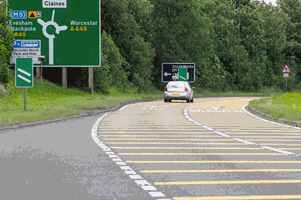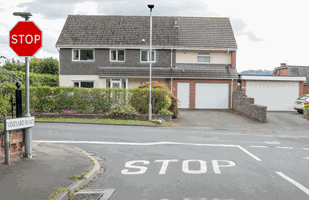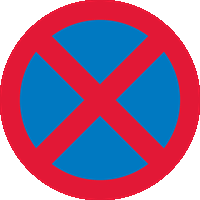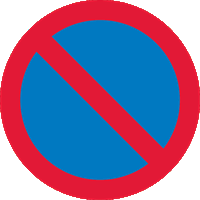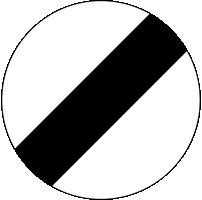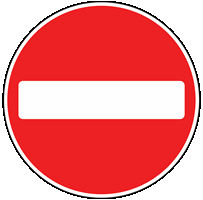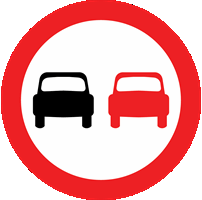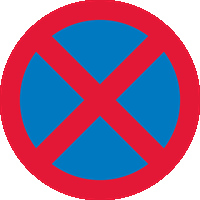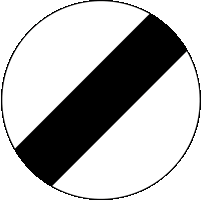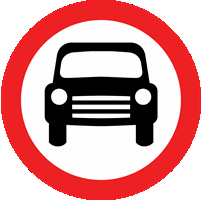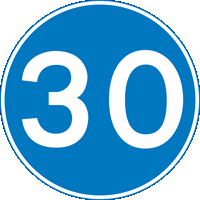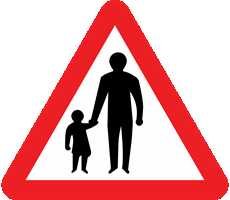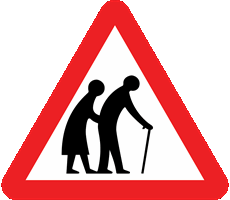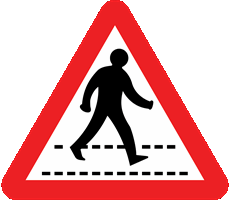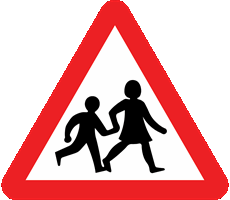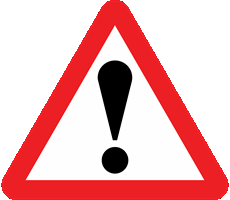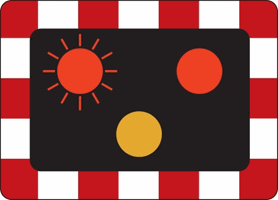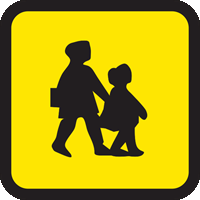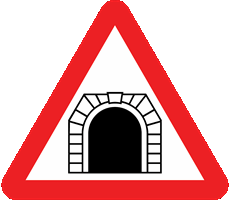You have 57 minutes to answer 50 multiple choice driving theory test questions. You need to answer at least 43 out of 50 questions correctly to pass. You can review your answer after each question or you can review all of your answers at the end of the test. Best of luck!
Test Quick View
Click question box to reveal the correct answer. You can print these questions out by clicking the printer icon.
Correct Answer: D
Explanation: These lines are a form of traffic calming measure. They are often present just before roundabouts and dangerous junctions. They prompt you to reduce your speed. You should look ahead and do this in good time.
Explanation: These lines are a form of traffic calming measure. They are often present just before roundabouts and dangerous junctions. They prompt you to reduce your speed. You should look ahead and do this in good time.
Correct Answer: A
Explanation: Unless a moving vehicle presents a danger, your horn should not be used between 11:30pm and 7am in built up areas or while stationary. The purpose of the horn is to let other road users know you're there.
Explanation: Unless a moving vehicle presents a danger, your horn should not be used between 11:30pm and 7am in built up areas or while stationary. The purpose of the horn is to let other road users know you're there.
Correct Answer: A
Explanation: The 'stop' sign has been placed here to encourage proper observation. The view onto the main road is obstructed, so you should stop and take time to thoroughly check your surroundings.
Explanation: The 'stop' sign has been placed here to encourage proper observation. The view onto the main road is obstructed, so you should stop and take time to thoroughly check your surroundings.
4. What should you do if you want to overtake a tractor but aren't sure if it's safe?
Mark one answer
B
C
D
Correct Answer: A
Explanation: You should never overtake if you're in any doubt it is safe to do so, even if stuck behind a slow vehicle like a tractor. Before overtaking, you should check you can see enough of the road ahead to guarantee the manoeuvre is safe. While being stuck behind a slow vehicle is frustrating, the few minutes gained by overtaking aren't worth the risk of collision.
Explanation: You should never overtake if you're in any doubt it is safe to do so, even if stuck behind a slow vehicle like a tractor. Before overtaking, you should check you can see enough of the road ahead to guarantee the manoeuvre is safe. While being stuck behind a slow vehicle is frustrating, the few minutes gained by overtaking aren't worth the risk of collision.
5. At a roundabout, which of these vehicles is most likely to take an unusual course?
Mark one answer
B
C
D
Correct Answer: B
Explanation: Due to their length, lorries and HGVs might need to take unusual courses around roundabouts to avoid mounting the centre of the roundabout. Be aware of this, and allow them plenty of space.
Explanation: Due to their length, lorries and HGVs might need to take unusual courses around roundabouts to avoid mounting the centre of the roundabout. Be aware of this, and allow them plenty of space.
Correct Answer: D
Explanation: This is a 'no entry' sign. Ignoring this sign could end up with you driving the wrong way down a one-way street, heightening danger for all other road users. In some cases, ignoring these signs is a prosecutable offence.
Explanation: This is a 'no entry' sign. Ignoring this sign could end up with you driving the wrong way down a one-way street, heightening danger for all other road users. In some cases, ignoring these signs is a prosecutable offence.
Correct Answer: B
Explanation: This is a 'no stopping' sign. These are often found in places where stopping will likely cause congestion, on clearways, for example.
Explanation: This is a 'no stopping' sign. These are often found in places where stopping will likely cause congestion, on clearways, for example.
Correct Answer: D
Explanation: This sign tells you that the minimum permitted speed is 30 mph. Signs like this are put in place to keep traffic flowing, and ward off vehicles that can't go faster than this. Despite there being a minimum speed limit, you should still stop or slow in the event of a queue, hazard, or collision.
Explanation: This sign tells you that the minimum permitted speed is 30 mph. Signs like this are put in place to keep traffic flowing, and ward off vehicles that can't go faster than this. Despite there being a minimum speed limit, you should still stop or slow in the event of a queue, hazard, or collision.
B
C
D
Correct Answer: A
Explanation: Always leave plenty of room when you pass pedestrians. Giving them enough room might require you to stray onto the right side of the road, so be sure to check the road ahead and your mirrors before pulling out. Don't overtake if you can't be completely sure it's safe.
Explanation: Always leave plenty of room when you pass pedestrians. Giving them enough room might require you to stray onto the right side of the road, so be sure to check the road ahead and your mirrors before pulling out. Don't overtake if you can't be completely sure it's safe.
Correct Answer: A
Explanation: This sign warns you of possible danger ahead. A second sign might warn of the specific hazard. In either scenario, be aware that you might have to adjust your course or speed, or even stop.
Explanation: This sign warns you of possible danger ahead. A second sign might warn of the specific hazard. In either scenario, be aware that you might have to adjust your course or speed, or even stop.
Correct Answer: A
Explanation: Wherever they appear, these flashing red lights mean you should stop even if the way ahead looks clear. You'll find them at level crossings, lifting or swing bridges, as well as at emergency access sites and airfields.
Explanation: Wherever they appear, these flashing red lights mean you should stop even if the way ahead looks clear. You'll find them at level crossings, lifting or swing bridges, as well as at emergency access sites and airfields.
B
C
D
Correct Answer: A
Explanation: Police officers wanting you to stop will flash their lights, indicate left, and point left to get you to pull over. It is mandatory to obey signals from police officers.
Explanation: Police officers wanting you to stop will flash their lights, indicate left, and point left to get you to pull over. It is mandatory to obey signals from police officers.
Correct Answer: C
Explanation: Checking the tyre pressures while tyres are cold gives a more accurate reading. Warm tyres - whether due to weather or long-distance driving - will show increased internal pressure.
Explanation: Checking the tyre pressures while tyres are cold gives a more accurate reading. Warm tyres - whether due to weather or long-distance driving - will show increased internal pressure.
Correct Answer: D
Explanation: You'll see this sign on school buses and coaches. Be wary of children emerging from behind the vehicle if it's stopped.
Explanation: You'll see this sign on school buses and coaches. Be wary of children emerging from behind the vehicle if it's stopped.
Correct Answer: B
Explanation: Learners are still building the skills and instincts they need to make safe decisions swiftly, and may need extra time and space on the road. Be patient and don't hurry them. The more comfortable they become with driving, the better they'll handle any given situation.
Explanation: Learners are still building the skills and instincts they need to make safe decisions swiftly, and may need extra time and space on the road. Be patient and don't hurry them. The more comfortable they become with driving, the better they'll handle any given situation.
16. What colour are the reflective studs on the left-hand lane of the carriageway on a motorway?
Mark one answer
B
C
D
Correct Answer: C
Explanation: Different coloured reflective studs are fixed to the road at the edges of motorways and between lanes. Red studs mark the boundary between the hard shoulder and the edge of the carriageway. Use reflective studs to identify which lane you're in in the dark.
Explanation: Different coloured reflective studs are fixed to the road at the edges of motorways and between lanes. Red studs mark the boundary between the hard shoulder and the edge of the carriageway. Use reflective studs to identify which lane you're in in the dark.
17. What should you do if a slow-moving lorry is displaying this sign in the middle lane of a motorway?
Mark one answer
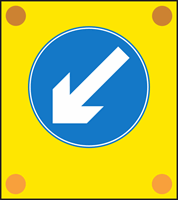
B
C
D
Correct Answer: B
Explanation: Slow-moving or stationary works vehicles often bear this sign. If overtaking, you should do so on the left, and be aware that there could be workers in the road nearby.
Explanation: Slow-moving or stationary works vehicles often bear this sign. If overtaking, you should do so on the left, and be aware that there could be workers in the road nearby.
Correct Answer: C
Explanation: If the nearest passing place is on the left, you should pull into it to allow the other vehicle past. If it's on the right, stop ahead of the passing place until the other vehicle pulls in, then continue. Be especially careful on single-track roads, as it's hard to see what's coming around bends, and because hedges often reduce visibility.
Explanation: If the nearest passing place is on the left, you should pull into it to allow the other vehicle past. If it's on the right, stop ahead of the passing place until the other vehicle pulls in, then continue. Be especially careful on single-track roads, as it's hard to see what's coming around bends, and because hedges often reduce visibility.
Correct Answer: A
Explanation: Only in genuine emergencies is it permitted to use the hard shoulder. If you suffer a breakdown and need to use it, make use of a roadside telephone to call for help. Roadside telephones give the operator your exact location. You shouldn't ever cross a slip road the carriageway to use a roadside phone.
Explanation: Only in genuine emergencies is it permitted to use the hard shoulder. If you suffer a breakdown and need to use it, make use of a roadside telephone to call for help. Roadside telephones give the operator your exact location. You shouldn't ever cross a slip road the carriageway to use a roadside phone.
B
C
D
Correct Answer: C
Explanation: A dog with a yellow or burgundy coat tells you the pedestrian with them is deaf. Take extra care, as the pedestrian may not hear you approaching, and might not hear your horn if you sound it in warning.
Explanation: A dog with a yellow or burgundy coat tells you the pedestrian with them is deaf. Take extra care, as the pedestrian may not hear you approaching, and might not hear your horn if you sound it in warning.
21. What is the purpose of the marked area between stop lines at some traffic light-controlled junctions?
Mark one answer
B
C
D
Correct Answer: C
Explanation: These are 'advanced stop lines', and provide an area for cyclists to get ahead of traffic when the lights go green. You should aim to stop at the first line if the lights go red or amber, but must stop at the second line if you've already crossed the first by the time the lights change, even though the area is reserved for cyclists.
Explanation: These are 'advanced stop lines', and provide an area for cyclists to get ahead of traffic when the lights go green. You should aim to stop at the first line if the lights go red or amber, but must stop at the second line if you've already crossed the first by the time the lights change, even though the area is reserved for cyclists.
22. How long should you spend checking to see if an unconscious casualty is breathing following an accident?
Mark one answer
B
C
D
Correct Answer: B
Explanation: Spend up to 10 seconds checking to see whether a casualty is breaking. Listen for breathing and check their airway is clear. Placing your cheek over their nose and mouth, feel for their break, and look for the rising and falling of their chest. If they don't appear to be breathing, begin chest compressions.
Explanation: Spend up to 10 seconds checking to see whether a casualty is breaking. Listen for breathing and check their airway is clear. Placing your cheek over their nose and mouth, feel for their break, and look for the rising and falling of their chest. If they don't appear to be breathing, begin chest compressions.
23. How many chest compressions should you give per minute to a casualty that isn't breathing properly following an accident?
Mark one answer
B
C
D
Correct Answer: C
Explanation: Placing two hands in the centre of the casualty's chest, you should push down 5-6 centimetres around twice per second (approx. 120 per minute). Chest compressions are only needed if the casualty isn't breathing normally.
Explanation: Placing two hands in the centre of the casualty's chest, you should push down 5-6 centimetres around twice per second (approx. 120 per minute). Chest compressions are only needed if the casualty isn't breathing normally.
Correct Answer: D
Explanation: This sign indicates that there's a tunnel ahead. You should always use dipped headlights in a tunnel - regardless of the time of day - and may need to lower your speed as you enter. Your eyes may need a moment to adjust to the lower level of light.
Explanation: This sign indicates that there's a tunnel ahead. You should always use dipped headlights in a tunnel - regardless of the time of day - and may need to lower your speed as you enter. Your eyes may need a moment to adjust to the lower level of light.
Correct Answer: C
Explanation: Place your finger in the casualty's mouth to check that their airway is clear, then tilt their head back to ensure their airway is open. If required, you can then begin mouth-to-mouth resuscitation. Unless there is further danger, don't move the casualty.
Explanation: Place your finger in the casualty's mouth to check that their airway is clear, then tilt their head back to ensure their airway is open. If required, you can then begin mouth-to-mouth resuscitation. Unless there is further danger, don't move the casualty.
Correct Answer: A
Explanation: Anything dangling from your rear view mirror or stuck to your windscreen could distract you from driving properly. Make sure you can see through your windscreen clearly.
Explanation: Anything dangling from your rear view mirror or stuck to your windscreen could distract you from driving properly. Make sure you can see through your windscreen clearly.
Correct Answer: D
Explanation: When visibility is poor during the day, it may be necessary to turn on your headlights and tail lights to help other drivers spot you. This is especially true in early morning or in late afternoon, when the operation of streetlamps might not be timed optimally to help drivers see clearly.
Explanation: When visibility is poor during the day, it may be necessary to turn on your headlights and tail lights to help other drivers spot you. This is especially true in early morning or in late afternoon, when the operation of streetlamps might not be timed optimally to help drivers see clearly.
Correct Answer: C
Explanation: Getting moving in the snow can be made easier by using a higher gear than normal. This supplies less turning force (torque) to the wheels, getting them spinning more gradually. This increases the likelihood that they'll grip properly.
Explanation: Getting moving in the snow can be made easier by using a higher gear than normal. This supplies less turning force (torque) to the wheels, getting them spinning more gradually. This increases the likelihood that they'll grip properly.
B
C
D
Correct Answer: A
Explanation: You should pull over and stop to rest somewhere safe. Before embarking on a long journey, you should plan your journey to take rest stops, leaving earlier if necessary. This helps prevent you becoming tired, and ensures you reach your destination on time.
Explanation: You should pull over and stop to rest somewhere safe. Before embarking on a long journey, you should plan your journey to take rest stops, leaving earlier if necessary. This helps prevent you becoming tired, and ensures you reach your destination on time.
30. What should you do if you want to turn right at a junction but parked cars are restricting your view?
Mark one answer
B
C
D
Correct Answer: D
Explanation: You should come to a complete stop, then creep forward until you get a good view of the road. Only emerge when you're entirely sure it's safe to do so.
Explanation: You should come to a complete stop, then creep forward until you get a good view of the road. Only emerge when you're entirely sure it's safe to do so.
Correct Answer: D
Explanation: Your engine will have to work harder when you're travelling up hill. You can help by switching to a lower gear to maintain your speed. Do this early, before you start to lose speed, to ensure you don't waste fuel getting back up to speed.
Explanation: Your engine will have to work harder when you're travelling up hill. You can help by switching to a lower gear to maintain your speed. Do this early, before you start to lose speed, to ensure you don't waste fuel getting back up to speed.
32. Following a breakdown on a two-way road, how far from your vehicle should you place a warning triangle?
Mark one answer
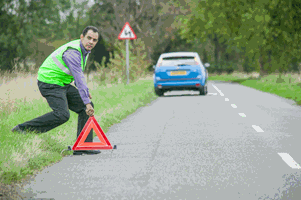
B
C
D
Correct Answer: D
Explanation: Advance warning triangles are used to warn other drivers that you've broken down or been involved in an incident. It should be placed at least 45 metres (147 feet) behind the obstruction, on the same side of the road or on the verge nearby. If the obstruction will be hard for approaching traffic to see (e.g. around a bend or in a dip), place it even further back. Advance warning triangles should not be used on motorways.
Explanation: Advance warning triangles are used to warn other drivers that you've broken down or been involved in an incident. It should be placed at least 45 metres (147 feet) behind the obstruction, on the same side of the road or on the verge nearby. If the obstruction will be hard for approaching traffic to see (e.g. around a bend or in a dip), place it even further back. Advance warning triangles should not be used on motorways.
33. What should you do if you break down on a level crossing, even if the lights haven't yet begun to flash?
Mark one answer
B
C
D
Correct Answer: B
Explanation: Getting everyone out of the vehicle and away from the crossing should be your first priority following a breakdown on a level crossing. Warn the signal operator via the railway telephone (if one is present), and only attempt to move the vehicle if the alarm signals are not yet on.
Explanation: Getting everyone out of the vehicle and away from the crossing should be your first priority following a breakdown on a level crossing. Warn the signal operator via the railway telephone (if one is present), and only attempt to move the vehicle if the alarm signals are not yet on.
Correct Answer: B
Explanation: Firstly, pull over onto the hard shoulder. High speed traffic on the carriageway poses a danger, so you should not attempt to repair the puncture or change the tyre. Instead, make your way to the nearest
Explanation: Firstly, pull over onto the hard shoulder. High speed traffic on the carriageway poses a danger, so you should not attempt to repair the puncture or change the tyre. Instead, make your way to the nearest
35. What should you do if your front fog lights are switched on but conditions are clear?
Mark one answer
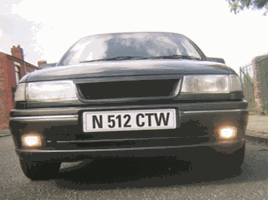
B
C
D
Correct Answer: C
Explanation: If visibility improves, you should turn off your fog lights. Don't leave them on in case the fog worsens again, but be prepared to reactivate them if visibility drops below 100 metres.
Explanation: If visibility improves, you should turn off your fog lights. Don't leave them on in case the fog worsens again, but be prepared to reactivate them if visibility drops below 100 metres.
Correct Answer: C
Explanation: Your vehicle and steering wheel will vibrate at higher speeds if your wheels are out of alignment. Take your vehicle to a garage or tyre fitter to rebalance the wheels, as this isn't a problem that will go away on its own.
Explanation: Your vehicle and steering wheel will vibrate at higher speeds if your wheels are out of alignment. Take your vehicle to a garage or tyre fitter to rebalance the wheels, as this isn't a problem that will go away on its own.
37. What should you do before you start driving following an argument with a friend?
Mark one answer
B
C
D
Correct Answer: B
Explanation: You shouldn't start your journey until you've calmed down. Driving while upset and angry is dangerous, because your concentration will be impacted.
Explanation: You shouldn't start your journey until you've calmed down. Driving while upset and angry is dangerous, because your concentration will be impacted.
B
C
D
Correct Answer: C
Explanation: Thieves may be deterred by your vehicle windows having its registration number etched onto its windows.
Explanation: Thieves may be deterred by your vehicle windows having its registration number etched onto its windows.
Correct Answer: B
Explanation: You can use your hazard warning lights to warn traffic behind on a motorway of a hazard up ahead. This quickly passes the message through traffic, reducing the risk of collision between slowing vehicles.
Explanation: You can use your hazard warning lights to warn traffic behind on a motorway of a hazard up ahead. This quickly passes the message through traffic, reducing the risk of collision between slowing vehicles.
Correct Answer: B
Explanation: Regular vehicle servicing can improve fuel consumption. Efficient engines produce fewer emissions and use less fuel, both reducing your impact on the environment and saving you money. Vehicle manufacturers usually provide servicing schedules, and keeping your car services according to these makes it more reliable and makes breakdowns less likely.
Explanation: Regular vehicle servicing can improve fuel consumption. Efficient engines produce fewer emissions and use less fuel, both reducing your impact on the environment and saving you money. Vehicle manufacturers usually provide servicing schedules, and keeping your car services according to these makes it more reliable and makes breakdowns less likely.
B
C
D
Correct Answer: A
Explanation: Ensure you can see all around your vehicle before attempting to turn your car around. Get someone to guide you if you're unable to get a good look around.
Explanation: Ensure you can see all around your vehicle before attempting to turn your car around. Get someone to guide you if you're unable to get a good look around.
Correct Answer: C
Explanation: Vehicle engines are less efficient when they're cold, and short journeys are less likely to warm the engine to an efficient level. Therefore, short journeys use more fuel and produce more emissions.
Explanation: Vehicle engines are less efficient when they're cold, and short journeys are less likely to warm the engine to an efficient level. Therefore, short journeys use more fuel and produce more emissions.
43. What should you do if you're driving past parked cars and you notice a bicycle wheel sticking out between them?
Mark one answer
B
C
D
Correct Answer: C
Explanation: A bicycle wheel poking out could indicate that a cyclist is about to move onto the road. You should slow down and prepare to stop. Anticipate that this could happen whenever you pass parked vehicles, as this will help you react more quickly when it does happen.
Explanation: A bicycle wheel poking out could indicate that a cyclist is about to move onto the road. You should slow down and prepare to stop. Anticipate that this could happen whenever you pass parked vehicles, as this will help you react more quickly when it does happen.
B
C
D
Correct Answer: B
Explanation: Dipping your mirror (also known as putting it inti the 'anti-dazzle' position) can help stop lights from traffic behind dazzling you. Dipping your mirror still lets you see behind you, but reduces the glare of any lights from behind.
Explanation: Dipping your mirror (also known as putting it inti the 'anti-dazzle' position) can help stop lights from traffic behind dazzling you. Dipping your mirror still lets you see behind you, but reduces the glare of any lights from behind.
45. What is the consequence of keeping your foot on the clutch for too long or staying in neutral?
Mark one answer
B
C
D
Correct Answer: B
Explanation: Staying in neutral or holding the clutch down for long periods is called coasting, and reduces the control you have over your vehicle. It's especially dangerous when going downhill, as gravity will cause your vehicle to pick up speed.
Explanation: Staying in neutral or holding the clutch down for long periods is called coasting, and reduces the control you have over your vehicle. It's especially dangerous when going downhill, as gravity will cause your vehicle to pick up speed.
46. How should you react to signs informing you that the right lane is closing in 800 yards, while driving on a dual carriageway?
Mark one answer
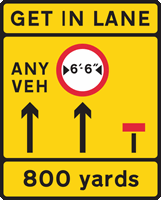
B
C
D
Correct Answer: D
Explanation: If you see a sign indicating that a lane is closing, move into an open lane in good time. Don't try to get ahead by leaving your lane change until the last minute, and don't try to push in.
Explanation: If you see a sign indicating that a lane is closing, move into an open lane in good time. Don't try to get ahead by leaving your lane change until the last minute, and don't try to push in.
Correct Answer: B
Explanation: Third-party insurance only covers damage and injury to others, and does not cover damage or injury to you or your vehicle. It is usually cheaper than comprehensive cover.
Explanation: Third-party insurance only covers damage and injury to others, and does not cover damage or injury to you or your vehicle. It is usually cheaper than comprehensive cover.
Correct Answer: C
Explanation: While coasting, you don't get the benefit of engine braking slowing you down or keeping your speed in check. You should avoid coasting generally, but especially at corners, junctions, and downhill sections of road. Instead, plan your approach to these hazards and select the correct gear early. You'll coast for a moment between gear changes, but that is unavoidable.
Explanation: While coasting, you don't get the benefit of engine braking slowing you down or keeping your speed in check. You should avoid coasting generally, but especially at corners, junctions, and downhill sections of road. Instead, plan your approach to these hazards and select the correct gear early. You'll coast for a moment between gear changes, but that is unavoidable.
49. What should you do if you're waiting at the side of the road to pick someone up, but know they might be a while?
Mark one answer
B
C
D
Correct Answer: C
Explanation: You should turn off your engine if you're likely to remain stationary for a while. This reduces fuel consumption and exhaust emissions, reducing your vehicle's impact on the planet.
Explanation: You should turn off your engine if you're likely to remain stationary for a while. This reduces fuel consumption and exhaust emissions, reducing your vehicle's impact on the planet.
50. Your car doesn't have anti-lock brakes. What should you do if you begin to skid while braking on a wet road?
Mark one answer
B
C
D
Correct Answer: D
Explanation: If you begin to skid while braking and do not have anti-lock brakes, you should release the footbrake and reapply it. You might need to do this a number of times before you're able to stop. These short pauses in braking allow the wheels to turn, and give you brief moments of steering control.
Explanation: If you begin to skid while braking and do not have anti-lock brakes, you should release the footbrake and reapply it. You might need to do this a number of times before you're able to stop. These short pauses in braking allow the wheels to turn, and give you brief moments of steering control.


